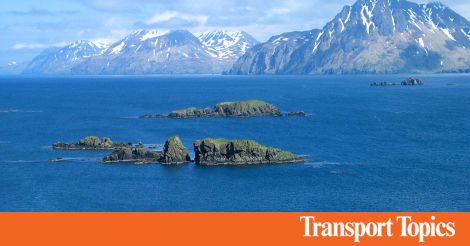The New Alaska Trail includes ports along the coast and rivers of southwestern and northern Alaska from the Aleutian Islands (shown) to the Canadian border. (Mjonsworth/Getty Images)
(Stay tuned for transfer news: Get TTNews in your inbox.)
Two new marine highway systems They added 250 miles of Ohio River system and 6,500 miles of Alaskan waterways to the national transportation system to improve freight shipments, U.S. Secretary of Transportation Buttigieg House announce.
“America’s Maritime Highways are vital links in our supply chains, helping to move goods quickly, cleanly, and efficiently,” Buttigieg declared on August 16. “By expanding our system of marine highways, we can strengthen our supply chains, improve port operations, and help keep goods affordable for American families.”
The Department of Transportation (DOT) defines a marine highway as a waterway in the United States or its territories that is navigable and can be used to transport goods.
He said, “Our country’s sea highway routes are navigable waterways capable of transporting large quantities of freight at lower costs than other modes of transportation.” Ann Phillipsboss Maritime administration.
There are now 31 designated marine highways; The federal government initiated the Marine Highway Program in 2010. Although the federal government does not operate marine highway services directly, it provides grants to develop and expand marine highway service operations to improve the integration of waterborne cargo into the intermodal surface transportation system in United State.
The federal government has awarded $91.6 million in competitive grants to eligible Marine Highway Service organizations to support the development and expansion of marine highways, ship and port/land infrastructure that are critical to creating supply chain resilience, Phillips noted earlier this year.
In March, it announced the availability of $12.4 million in grants for fiscal year 2023 through the Maritime Highway Program.
The new Alaska Highway (named M-11) will be overseen by Alaska Department of Transportation and Utilities. The new waterway includes ports along the coast and rivers of southwestern and northern Alaska from the Aleutian Islands to the Canadian border. The Department of Transportation notes that many communities rely on a system of ports, rivers, landings, and airports to move goods and people. The new M-11 route aims to give businesses and residents of the region more transportation options over the waterways.
Pennsylvania and West Virginia residents will benefit from the new M-79 Maritime Highway, co-sponsored by Port of Pittsburgh Authority and the Morgantown Monongalia Urban Planning Organization (MMMPO) in West Virginia. The new Marine Highway designation now extends the Ohio River system by about 250 miles, adding tributary rivers farther east.
Local commercial interests in the region, including river terminals and operators, are looking to transportation by water as a reliable and cost-effective alternative to other forms of surface transportation. The M-79 will act as a catalyst for increased operations and investments in infrastructure and freight traffic, especially for new goods that will move on water in the future,” the DOT stated.
According to the MMMPO Transport Plan May 2022The towns of Monongalia and Morgantown are historically linked by the Monongahela River, which connects the area to Pittsburgh. Although the river used to carry more efficient freight into the Ohio River Valley and was dominated by shipments of lumber and coal, today it transports mostly coal and limestone out of West Virginia.
